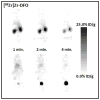Standardized methods for the production of high specific-activity zirconium-89
- PMID: 19720285
- PMCID: PMC2827875
- DOI: 10.1016/j.nucmedbio.2009.05.007
Standardized methods for the production of high specific-activity zirconium-89
Abstract
Zirconium-89 is an attractive metallo-radionuclide for use in immuno-PET due to favorable decay characteristics. Standardized methods for the routine production and isolation of high-purity and high-specific-activity (89)Zr using a small cyclotron are reported. Optimized cyclotron conditions reveal high average yields of 1.52+/-0.11 mCi/muA.h at a proton beam energy of 15 MeV and current of 15 muA using a solid, commercially available (89)Y-foil target (0.1 mm, 100% natural abundance). (89)Zr was isolated in high radionuclidic and radiochemical purity (>99.99%) as [(89)Zr]Zr-oxalate by using a solid-phase hydroxamate resin with >99.5% recovery of the radioactivity. The effective specific-activity of (89)Zr was found to be in the range 5.28-13.43 mCi/microg (470-1195 Ci/mmol) of zirconium. New methods for the facile production of [(89)Zr]Zr-chloride are reported. Radiolabeling studies using the trihydroxamate ligand desferrioxamine B (DFO) gave 100% radiochemical yields in <15 min at room temperature, and in vitro stability measurements confirmed that [(89)Zr]Zr-DFO is stable with respect to ligand dissociation in human serum for >7 days. Small-animal positron emission tomography (PET) imaging studies have demonstrated that free (89)Zr(IV) ions administered as [(89)Zr]Zr-chloride accumulate in the liver, whilst [(89)Zr]Zr-DFO is excreted rapidly via the kidneys within <20 min. These results have important implication for the analysis of immuno-PET imaging of (89)Zr-labeled monoclonal antibodies. The detailed methods described can be easily translated to other radiochemistry facilities and will facilitate the use of (89)Zr in both basic science and clinical investigations.
Figures








References
-
- van Dongen GAMS, Visser GWM, Lub-de Hooge MN, de Vries EG, Perk LR. Immuno-PET: a navigator in monoclonal antibody development and applications. Oncologist. 2007;12:1379–89. - PubMed
-
- Wu AM. Antibodies and antimatter: The resurgence of immuno-PET. J Nucl Med. 2009;50:2–5. - PubMed
-
- Mustafa MG, West HIJ, O’Brien H, Lanier RG, Benhamou M, Tamura T. Measurements and a direct-reaction plus Hauser-Feshbach analysis of 89Y(p,n)89Zr, 89Y(p,2n)88Zr, and 89Y(p,pn)88Y reactions up to 40 MeV. Phys Rev C. 1988;38:1624–37. - PubMed
Publication types
MeSH terms
Substances
Grants and funding
LinkOut - more resources
Full Text Sources
Other Literature Sources

